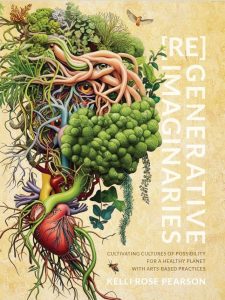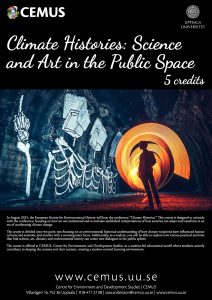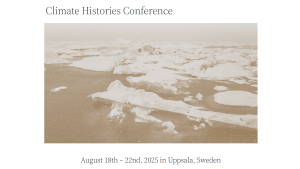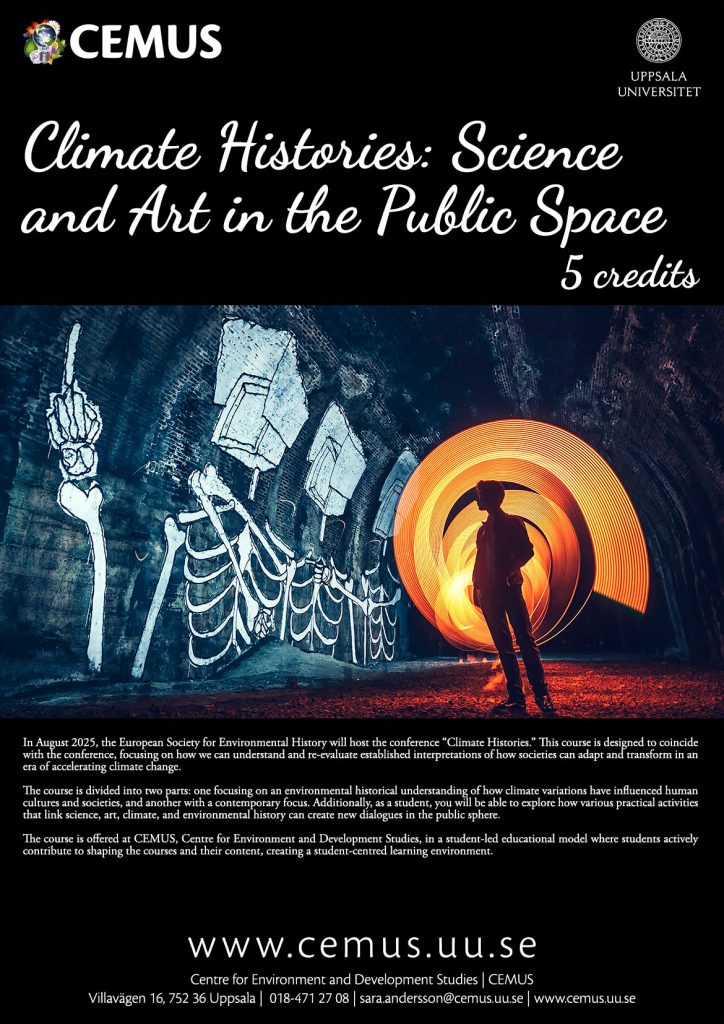
Warmly welcome to the Climate Histories course summer 2025!
The course starts August 7, runs full time during the rest of the month and ends August 29, 2025, with the hand in of the final examination at 17.00.
The course consists of a part 1 running between August 7-15 consisting of a course introduction, some scheduled online classes and self-study, online lectures, videos, podcasts, texts and reading of the course book, and a mandatory online seminar Friday August 15.
Part 2 is in-person in Uppsala during the Climate Histories conference August 18-22 with examination consisting of students (that’s you) organizing interactive activities with focus on climate, history, science, art in a public space.
During the third and final part August 25-29 you finalize your descriptive and reflective text over the activity you organized (project report) and take part in the final mandatory seminar Friday August 29.
Looking forward to seeing you all in August!
Daniel Mossberg and Anneli Ekblom
Schedule and online parts
The course is scheduled as follows:
- August 7 at 9.15-11.00: Online course introduction with Daniel Mossberg, Educational coordinator CEMUS, Uppsala University and lecture by Anneli Ekblom, Professor at Department of Archaeology, Ancient History and Conservation, Uppsala University
- August 11 at 10.15-12.00: Online with Julia Lohmann, Associate Professor Aalto University
- August 12 at 13.15-15.00: Campus and online with Signe Johannessen, Norwegian artist https://signejohannessen.se/
- August 13 at 10.15-12.00: Online with Anneli Ekblom, Professor Department of Archaeology, Ancient History and Conservation, Uppsala University
- August 14 at 10.15-12.00: Online with Rebecka Wigh Abramsson, Uppsala Art Museum
- August 15 at 10.15-12.00: Online mandatory seminar for part 1
- August 7-14: Self-study, online lectures, videos, podcasts, texts https://www.cemus.uu.se/clihi-part-1/ and reading of course book
Part 2 Uppsala August 18-22: Climate Histories conference and your interactive activity
- Open sessions and events as part of the Climate Histories conference, see https://eseh2025.com/ for updates and details
- Climate, history, science, art in a public space activities organized by students
- Your own writing, reflecting process
- August 29 at 13.15-15.00: Online mandatory seminar for part 3
Course literature
During the course you will read one book (mandatory). Click on book cover for free open access.
 Pearson K. R. (2025). [Re]Generative Imaginaries: Cultivating Cultures of Possibility for a Healthy Planet with Arts-Based Practices. Wageningen: Wageningen University
Pearson K. R. (2025). [Re]Generative Imaginaries: Cultivating Cultures of Possibility for a Healthy Planet with Arts-Based Practices. Wageningen: Wageningen University
Direct link: https://edepot.wur.nl/681063
Tech and communication
To be able to study the course you will need a computer, tablet or smartphone with access to the internet. Seminars, workshop and online meetings will be easier if you have external headphones with a microphone. It’s important that you download Zoom here: https://www.uu.se/en/students/it-for-students/software/zoom and install it on the device you’re using for the course. You can test video and audio in the settings.
Course coordinator Daniel Mossberg is available every week day Monday to Friday via text/sms 073-065 02 28, call if there’s anything urgent. Emails will be responded to within one week at daniel.mossberg[a]cemus.uu.se.
Examination schedule
Mandatory assignments, seminars and examination deadline are scheduled as follows (links to submit assignments in Studium coming):
Part 1: The student is examined through written preparation for and active participation in seminars and workshops (1,5 credit)
- August 15 at 09.00: Submit written preparation assignment for part 1 and your plan for interactive activity the following week
- August 15 at 10.15-12.00: Mandatory online seminar for part 1 https://uu-se.zoom.us/j/68579048755
Part 2: The student is examined through oral presentation of a project (1 credit)
- August 18-22 your interactive activity with focus on climate, history, science, art in a public space (time and place decided at seminar August 15)
Part 3: The student is examined through written documentation of a project (2 credits)
- August 29 at 12.00: Submit descriptive and reflective text over the activity you organized (project report)
Part 3: The student is examined through active participation in seminars and workshops (0,5 credit)
- August 29 at 13.15-15.00 Mandatory online seminar for part 3 https://uu-se.zoom.us/j/68579048755
Syllabus and learning outcomes
You can read the syllabus here: Climate Histories: Science and Art in the Public Space. The course goals that are examined are:
On completion of the course, the student should be able to:
- account for how climate variations have affected different humans and environments; [part 1]
- critically discuss climate and sustainability challenges in a global and local context; [part 1]
- critically discuss how artistic expressions and scientific knowledge interact in the communication of climate change in public space; [part 3]
- organise interactive activities with focus on climate, history, science, art in a public space. [part 2]
Grading criteria
About the course
 In August 2025, the European Society for Environmental History will host the conference “Climate Histories.” This course is designed to coincide with the conference, focusing on how we can understand and re-evaluate established interpretations of how societies can adapt and transform in an era of accelerating climate change.
In August 2025, the European Society for Environmental History will host the conference “Climate Histories.” This course is designed to coincide with the conference, focusing on how we can understand and re-evaluate established interpretations of how societies can adapt and transform in an era of accelerating climate change.
The course is divided into two parts: one focusing on an environmental historical understanding of how climate variations have influenced human cultures and societies, and another with a contemporary focus. Additionally, as a student, you will be able to explore how various practical activities that link science, art, climate, and environmental history can create new dialogues in the public sphere.
About the Climate Histories conference
 Environmental history is a powerful form of storytelling.
Environmental history is a powerful form of storytelling.
Under the ‘Climate Histories’ theme we ask, how might we rethink the written and material records of social adaptabilities and transformations to understand better what it means to live through an era of rapid climate change?
Though the climate crises of today are unprecedented, all societies have negotiated the passing of the seasons and of long and short spells of floods, droughts and unusual cold periods. As catastrophic events attest to the undeniable effects of climate change, we are reminded of the historical depth of living with climate variability. The cry of the hunger stones that were exposed due to the central European droughts – If you see me weep – serves as a signal to consider the bad years which have been and will return.
This conference then will act as a record in itself, a 2025 ‘hunger stone’ capable of documenting and reflecting on how climate change is experienced today and in the past.
Read more about the conference here: https://eseh2025.com/
CEMUS
The course is offered at CEMUS, the Centre for Environment and Development Studies, in a student-led educational model where students actively contribute to shaping the courses and their content, creating a student-centred learning environment.
Syllabus
Link to syllabus.
Summer 2025, 100%, Campus, Mixed
Application at antagning.se »
Study period: 7 August 2025 – 31 August 2025
Application Deadline: 17 March 2025
Application code: UU-19510 Application
Language of Instruction: English
Location: Uppsala
Selection: Final school grades (40%) – Swedish Scholastic Aptitude Test (10%) – Higher education credits, maximum 165 credits (50%)
Entry Requirements: 60 credits
Fees: If you are not a citizen of a European Union (EU) or European Economic Area (EEA) country, or Switzerland, you are required to pay application and tuition fees. Read more about fees.
Application Fee: SEK 900
Tuition fee, first semester: SEK 10 833
Tuition fee, total: SEK 10 833

